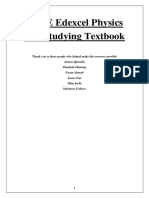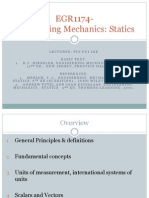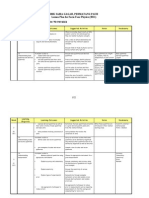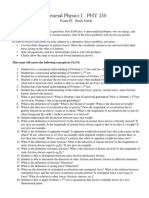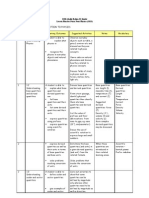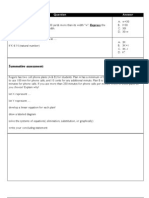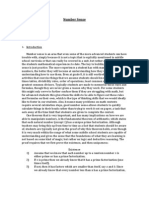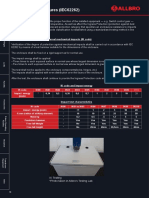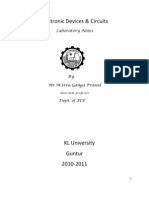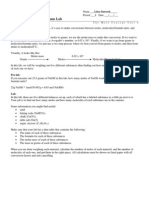Poster
Poster
Uploaded by
api-231033473Copyright:
Available Formats
Poster
Poster
Uploaded by
api-231033473Original Title
Copyright
Available Formats
Share this document
Did you find this document useful?
Is this content inappropriate?
Copyright:
Available Formats
Poster
Poster
Uploaded by
api-231033473Copyright:
Available Formats
PHYSICS 12 UNIT 1 DYNAMIC EXTENSION
Introduction
Dynamics is the study of the factors that cause change in speed, direction, and whey an object moves the way it does. This unit main focus is on motion of objects in one dimensional forces and with the application of Newtons laws. It also introduce s briefly the concept of collisions and momentum .
Curriculum Outcomes:
This unit continues the study of motion in Science 10. It leads student to more sophisticated concepts of energy and momentum that are necessary to study the interactions between masses. Further in unit 2will develop the two dimensional situation, uniform circular motion, and Keplers Laws.
Curriculum Outcomes:
Able to use Vector Analysis in two dimensions for systems involving two or more masses, relative motions, static equilibrium, and static torques(ACP-1). Use vectors to represent forces (325-5) To apply the law of conservation to one dimensional collision and explosion(326-3). To determine in which real-life situations involving elastic and inelastic interactions the law of conservation of momentum and energy are best used(326-4).
Order of Lessons :
Lesson Lesson Lesson Lesson 1 - Introduction to Vectors 2 - Using vectors to calculate a resultant Force 3 Law of Conversation of Momentum 4 Systems involving elastic and Inelastic interactions
Momentum is a physics term; it refers to the quantity of motion that an Head-to-Tail Using Trigonometry
object has. A sports team that is on the move has the momentum. If an object is in motion (on the move) then it has momentum. Momentum can be defined as "mass in motion. All objects have mass; so if an object is moving , then it has momentum - it has its mass in motion. Momentum = mass velocity In physics, the symbol for the quantity momentum is the lower case "p". Thus, the above equation can be rewritten as p=mv
=
Change in momentum is a result of change in velocity.
Estimated time: 20-25 hours
Teaching time/day: 55-60min OBJ: Lesson Objective
ASS: Assignment/Homework
Conservation of Momentum . + . = . + . (elastic) . + . = ( + ). (inelastic)
= Key Concepts, Definitions,
What are Vectors? A vector is a quantity or phenomenon that has two independent properties: magnitude and direction. The term also denotes the mathematical or geometrical representation of such a quantity. Examples of vectors in nature are velocity, momentum, force, and weight. (Weight is the force produced by the acceleration of gravity acting on a mass.) What are Scalars? A quantity or phenomenon that exhibits magnitude only, with no specific direction, is called a scalar. Examples of scalars include speed, mass, time. Resultant Vector? The "resultant" is the description (magnitude and direction) of a single vector that would have the same effect as the two or more vectors have when they're all acting at the same time.
The momentum changes are equal in magnitude and opposite in direction.
Elastic Collision
Inelastic Collision
Five steps problem solving in Physics: 1. 2. 3. 4. Read the problem carefully and develop a mental picture of the physical situation. If needed, sketch a simple diagram of the physical situation to help visualize it. Identify the known and unknown quantities in an organized manner, often times record them on the diagram itself. Outline a strategy for solving for the unknown quantity; the strategy will typically center around the use of physics equations and understanding of physics principles. Identify the appropriate formula(s) to use, often times write them down.
5. Perform substitutions and algebraic manipulations in order to solve for the unknown quantity.
References:
1. 2. 3. 4. 5. 6. 7. Acedemic!, A.(2011). Wordle - Beautiful Word Clouds. Wordle - Beautiful Word Clouds. Retrieved February 23, 2013, from http://www.wordle.net/ Dufresne, R. J., & Gerace, W. J. (2004). Assessing-To-Learn: Formative Assessment in Physics Instruction. Physics Teacher, 42(7), 428-433. doi:10.1119/1.1804662 Keeley, P. (2008). Science Formative Assessment: 75 Practical Strategies for Linking Assessment, Instruction and Learning. Corwin Press, Thousand Oaks, CA. "Khan Academy." Khan Academy. N.p., 2006. Web. 23 Feb. 2013. <https://www.khanacademy.org/ "Lesson Plans & Worksheets for School Teachers | Lesson Planet." Lesson Plans & Worksheets for School Teachers | Lesson Planet. N.p.,1999. Web. 24 Feb. 2013. <http://www.lessonplanet.com/>. Physics.org | Home. (2006). physics.org | Home. Retrieved February 23, 2013, from http://www.physics.org/ The Physics Classroom. (1996). The Physics Classroom. Retrieved February 23, 2013, from http://www.physicsclassroom.com
Inelastic Collision
How to find the Resultant Vector?
Head-to-Tail Method
(Line up the vectors in a line from head to tail, maintaining their magnitude and direction. The resultant vector goes from the tail (start) of the first vector to the head of the last vector. Using Trig Functions Add together the X components of each vector, add together the Y components of each vector and use trigonometry to find the magnitude of the resultant vector.
Designed by Farzad Saeidi Feb 28,2013 Poster size: 36 x 24 [ED4511 - Advanced Studies in Science Education] fsaeidi@unb.ca
You might also like
- Central Battery System Cooper LTDDocument137 pagesCentral Battery System Cooper LTDnbabous75% (4)
- Module 1 - Introduction To Mechanics PDFDocument10 pagesModule 1 - Introduction To Mechanics PDFsubyNo ratings yet
- Gen Physics 1 FIRST QUARTER RevisedDocument56 pagesGen Physics 1 FIRST QUARTER RevisedZohan KimNo ratings yet
- OscillationslessonplanDocument6 pagesOscillationslessonplan9567535991No ratings yet
- 1.1 Introduction To DynamicsDocument12 pages1.1 Introduction To DynamicsGian SanchezNo ratings yet
- JozeeettDocument4 pagesJozeeettMarifel Amor Dusal PerameNo ratings yet
- 9th Grade CurriculaDocument2 pages9th Grade Curriculabugrahankilic13No ratings yet
- PHY 143 Course OutlineDocument3 pagesPHY 143 Course Outlinesurvanity wilsonNo ratings yet
- GCSE Edexcel Physics Self-Studying TextbookDocument100 pagesGCSE Edexcel Physics Self-Studying TextbookFaith KurzbergNo ratings yet
- TERM 1 - Ebook Physics 10Document65 pagesTERM 1 - Ebook Physics 10patricia chloe awatNo ratings yet
- Lesson-1-Intro-to-Engg-Mechanics-Sept-19-2024Document41 pagesLesson-1-Intro-to-Engg-Mechanics-Sept-19-2024Calie BearNo ratings yet
- Basic Concepts of Engineering MechanicsDocument19 pagesBasic Concepts of Engineering MechanicsayingbaNo ratings yet
- Course Outline: - Week 1, January 4 and 6Document23 pagesCourse Outline: - Week 1, January 4 and 6Michael DemianNo ratings yet
- nts112 4th Grading NotesDocument20 pagesnts112 4th Grading NotesMichelle AnnNo ratings yet
- Overviews of StaticsDocument70 pagesOverviews of StaticsJacous Wcy100% (1)
- Engineering Mechanics Statics 1630433197 PDFDocument500 pagesEngineering Mechanics Statics 1630433197 PDFVerónica GonzalezNo ratings yet
- Monday 29 Jan 2024 CH 12 Intro and Rectilinear Motion With ProblemsDocument29 pagesMonday 29 Jan 2024 CH 12 Intro and Rectilinear Motion With ProblemsEros IonNo ratings yet
- RPT Fizik f4&f5 2015Document19 pagesRPT Fizik f4&f5 2015NorSafarien RahimNo ratings yet
- Module 1 Dynamics of Rigid BodiesDocument11 pagesModule 1 Dynamics of Rigid BodiesBilly Joel DasmariñasNo ratings yet
- Chapter - 1 - PhysicsDocument14 pagesChapter - 1 - PhysicsmechboyzNo ratings yet
- Energy Work Power Document DocumentDocument22 pagesEnergy Work Power Document Documentcuibonnie575No ratings yet
- 1 - Intro and Rectilinear Motion With ProblemsDocument29 pages1 - Intro and Rectilinear Motion With ProblemsSuhaib IntezarNo ratings yet
- Physics Yearly Lesson Plan f4Document22 pagesPhysics Yearly Lesson Plan f4Rubiah BasriNo ratings yet
- Engineering Mechanics: Statics Lecture 1 PDFDocument16 pagesEngineering Mechanics: Statics Lecture 1 PDFKhalid YousafNo ratings yet
- Chapter 1 - Introduction To MechanicsDocument14 pagesChapter 1 - Introduction To MechanicsrushdiNo ratings yet
- Engineering Mechanics: Distinction Between Branches of PhysicsDocument4 pagesEngineering Mechanics: Distinction Between Branches of PhysicsVenkatesan DevendranNo ratings yet
- Untitled Document 46Document4 pagesUntitled Document 46Mansi PundheerNo ratings yet
- static lectursDocument54 pagesstatic lecturswww.mohaalrafy361No ratings yet
- PHYSICS Alevel AQA 7407 Unit 4 Mechanics and MaterialsDocument41 pagesPHYSICS Alevel AQA 7407 Unit 4 Mechanics and MaterialsValentina R. RusevaNo ratings yet
- Simple Harmonic Motion Unit Plan 2014-03-26Document3 pagesSimple Harmonic Motion Unit Plan 2014-03-26sk112No ratings yet
- Rotational Equilibrium: Provided by TryengineeringDocument22 pagesRotational Equilibrium: Provided by TryengineeringLuisa MartinesNo ratings yet
- Physics Grade 9 SummaryDocument12 pagesPhysics Grade 9 Summaryvaneliana5387No ratings yet
- IGCSE Physics Year 11 Notes 2014 2015Document31 pagesIGCSE Physics Year 11 Notes 2014 2015su100% (1)
- Reflection PaperDocument4 pagesReflection PaperShirwinNo ratings yet
- 2-Week ISTE Workshop: Engineers MechanicsDocument11 pages2-Week ISTE Workshop: Engineers MechanicsJigar SutharNo ratings yet
- Mathematics Extension 2 Year 12 Topic Guide MechanicsDocument14 pagesMathematics Extension 2 Year 12 Topic Guide MechanicsTony TranNo ratings yet
- Phys 7221 HomeworkDocument5 pagesPhys 7221 Homeworkpihogowlf100% (1)
- Lecture 1 Introduction To Statics and Force VectorsDocument27 pagesLecture 1 Introduction To Statics and Force VectorsChloe SaludesNo ratings yet
- Physic 1 - Lecture 0Document17 pagesPhysic 1 - Lecture 010223035No ratings yet
- Introduction To PhysicsDocument2 pagesIntroduction To PhysicsYhamNo ratings yet
- Basic Mechanics-167 Unit1introDocument30 pagesBasic Mechanics-167 Unit1intronewtoneugene344No ratings yet
- Force and MotionDocument41 pagesForce and MotiondzveaNo ratings yet
- Western Colleges, Inc.: PreliminariesDocument10 pagesWestern Colleges, Inc.: PreliminariesMarvel Felicity Rosell ArmestoNo ratings yet
- 6 Force and Motion Unit TemplateDocument9 pages6 Force and Motion Unit TemplateSuryanshu BhardwajNo ratings yet
- Applied Mathematics Am 02Document8 pagesApplied Mathematics Am 02sahidNo ratings yet
- Oct 2004 Classroom 1Document16 pagesOct 2004 Classroom 1asuhassNo ratings yet
- PHY130 Exam#2 StudyGuideDocument2 pagesPHY130 Exam#2 StudyGuideSagar GogiaNo ratings yet
- Course Book: Koya UniversityDocument24 pagesCourse Book: Koya UniversityMariwan MirNo ratings yet
- Differential_equations_Solving_the_oscillation_sysDocument7 pagesDifferential_equations_Solving_the_oscillation_sysBrijesh MishraNo ratings yet
- Physics Form 4 Yearly Lesson Plan2013Document21 pagesPhysics Form 4 Yearly Lesson Plan2013jacylin_a_663291230No ratings yet
- Chapter 1Document28 pagesChapter 1Dina Rivera RabilasNo ratings yet
- Physics 20 OutlineDocument2 pagesPhysics 20 OutlineTim AllenNo ratings yet
- Engineering MechanicsDocument112 pagesEngineering Mechanicsch pavan kumarNo ratings yet
- Daily Dose - Simplified Learning Material (2021-22) : Class Subject Unit No. & Name Chapter No. & Name TopicDocument7 pagesDaily Dose - Simplified Learning Material (2021-22) : Class Subject Unit No. & Name Chapter No. & Name TopicIsha GargNo ratings yet
- Simple Harmonic Motion CourseworkDocument7 pagesSimple Harmonic Motion Courseworkvfbgttvcf100% (2)
- Module Physics For EngineersDocument43 pagesModule Physics For EngineersASTRERO John Denver F.No ratings yet
- Fundamentals of Engineering MechanicsDocument19 pagesFundamentals of Engineering MechanicsayingbaNo ratings yet
- Cordy J s20646 Etl304 Ass3Document26 pagesCordy J s20646 Etl304 Ass3api-256832695No ratings yet
- Barron's Physics Practice Plus: 400+ Online Questions and Quick Study ReviewFrom EverandBarron's Physics Practice Plus: 400+ Online Questions and Quick Study ReviewNo ratings yet
- ReferencesDocument1 pageReferencesapi-231033473No ratings yet
- Word ProblemsDocument2 pagesWord Problemsapi-231033473No ratings yet
- LessonsDocument4 pagesLessonsapi-231033473No ratings yet
- Rubric For Word ProblemsDocument2 pagesRubric For Word Problemsapi-231033473100% (1)
- Unit PlanDocument34 pagesUnit Planapi-231033473No ratings yet
- Collection of Lesson PlansDocument4 pagesCollection of Lesson Plansapi-231033473No ratings yet
- Dan - ProbabilityDocument5 pagesDan - Probabilityapi-231033473No ratings yet
- Dan - Number SenseDocument6 pagesDan - Number Senseapi-231033473No ratings yet
- Dan - Patterns and RelationsDocument5 pagesDan - Patterns and Relationsapi-231033473No ratings yet
- REACT-3.6-4.6 BCD.00386 EN RevBDocument6 pagesREACT-3.6-4.6 BCD.00386 EN RevBbudituxNo ratings yet
- Taitel and Dukler Horizontal ModelsDocument9 pagesTaitel and Dukler Horizontal ModelsAli SultanNo ratings yet
- Steam Power PlantDocument20 pagesSteam Power PlantSiddi Sampath Kumar Reddy100% (1)
- Reference Data - : Metric Conversion ChartDocument29 pagesReference Data - : Metric Conversion ChartkanchanabalajiNo ratings yet
- LM 5010Document32 pagesLM 5010ed251No ratings yet
- TN-2003 Motor Sizing 101Document14 pagesTN-2003 Motor Sizing 101jingyong123No ratings yet
- Res lvk-3082595Document4 pagesRes lvk-3082595f4bxwNo ratings yet
- E-Catalogue Bicc - 150 Kv-r04Document1 pageE-Catalogue Bicc - 150 Kv-r04bimbremboNo ratings yet
- CBSE Class 12 Physics Electrostatics Practice MCQ SolutionsDocument25 pagesCBSE Class 12 Physics Electrostatics Practice MCQ SolutionsSmitha ThomasNo ratings yet
- Lecture # 23 ELEN PDFDocument10 pagesLecture # 23 ELEN PDFPhD EENo ratings yet
- Potential Energy Review: XerfranzDocument31 pagesPotential Energy Review: XerfranzRyan BringinoNo ratings yet
- Celerity Formula, KortewagDocument19 pagesCelerity Formula, Kortewaggaurav vermaNo ratings yet
- Solution: Chapter 12 ProblemsDocument5 pagesSolution: Chapter 12 Problemstangent12No ratings yet
- Multiple Choice Question (MCQ) - Mass Transfer - Multiple Choice Question (MCQ) For Chemical Engineering PDFDocument20 pagesMultiple Choice Question (MCQ) - Mass Transfer - Multiple Choice Question (MCQ) For Chemical Engineering PDFMuthu KumarNo ratings yet
- IK Ratings For Enclosures (IEC62262) : Degree of Protection Against External Mechanical Impacts (IK Code)Document1 pageIK Ratings For Enclosures (IEC62262) : Degree of Protection Against External Mechanical Impacts (IK Code)fajar agungNo ratings yet
- 3 EDC Lab ManualDocument73 pages3 EDC Lab ManualVijayalakshmi PrakashNo ratings yet
- Enthalpique R 1234yfDocument1 pageEnthalpique R 1234yfJayesh KumavatNo ratings yet
- Logix SERCOS Tuning Tips v1.02 1Document6 pagesLogix SERCOS Tuning Tips v1.02 1José AlanizNo ratings yet
- Ib Phy Gag Add 9Document15 pagesIb Phy Gag Add 9ANTONIOSNo ratings yet
- Equivalent Buckling Length of Non-Uniform Members PDFDocument18 pagesEquivalent Buckling Length of Non-Uniform Members PDFIvan KlyuchkaNo ratings yet
- U4 Lab 1 Moles Molecules and Grams 3Document4 pagesU4 Lab 1 Moles Molecules and Grams 3api-239474508No ratings yet
- اختبار حاسبات فيز2 ترم صيفي 2020-2021Document12 pagesاختبار حاسبات فيز2 ترم صيفي 2020-2021Nabel MohamedNo ratings yet
- Electrical SystemsDocument24 pagesElectrical SystemsLokeshNo ratings yet
- Status Code RAPs For XEROX 6204Document28 pagesStatus Code RAPs For XEROX 6204ValdemarNo ratings yet
- Nortronics Silver CatalogDocument90 pagesNortronics Silver CatalogCorneliuD.TanasaNo ratings yet
- Work Done in Compressor - Alighar Muslim UniversityDocument8 pagesWork Done in Compressor - Alighar Muslim UniversityAktarojjaman MiltonNo ratings yet
- Ship CentroidsDocument50 pagesShip CentroidsGraham WestbrookNo ratings yet
- Weight-Volume Relationships: Quiz Gt102Document8 pagesWeight-Volume Relationships: Quiz Gt102Sharon Rose OcampoNo ratings yet
- Rates Revision1Document2 pagesRates Revision1phineas123No ratings yet








